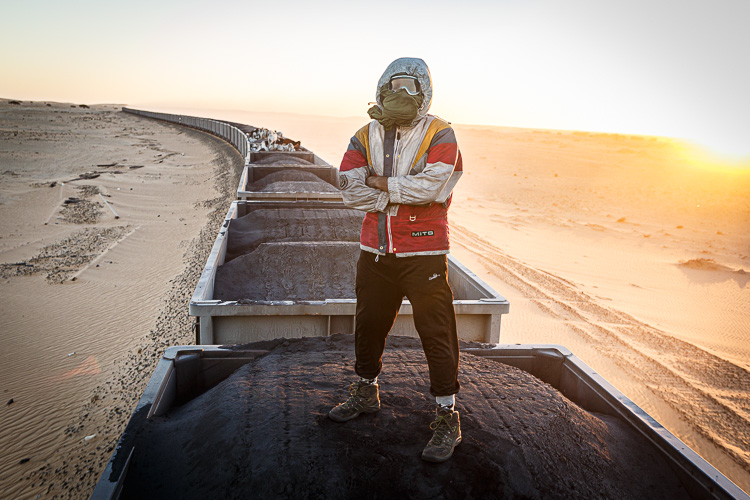
Imagine riding the longest train in the world, through endless deserts, all by yourself. I travelled to Mauritania and rode the iron ore train, making a long time dream come true. There was very little comfort, but it was beyond epic.
Since not many people can point Mauritania (not Mauritius!) on a map, let me first give you a short introduction. The country is located in northwest Africa, sharing among others a large mined border with the disputed Western Sahara and another with trouble-struck Mali. As a former French colony, the multi-ethnic Sahel country is now ruled by strict islamic principles.
Mauritania is huge, three times the size of Germany. It is also home to just 4 million beating hearts, making it pretty much a big and empty open-air desert country. There are possibly more goats and camels than people living in Mauritania…
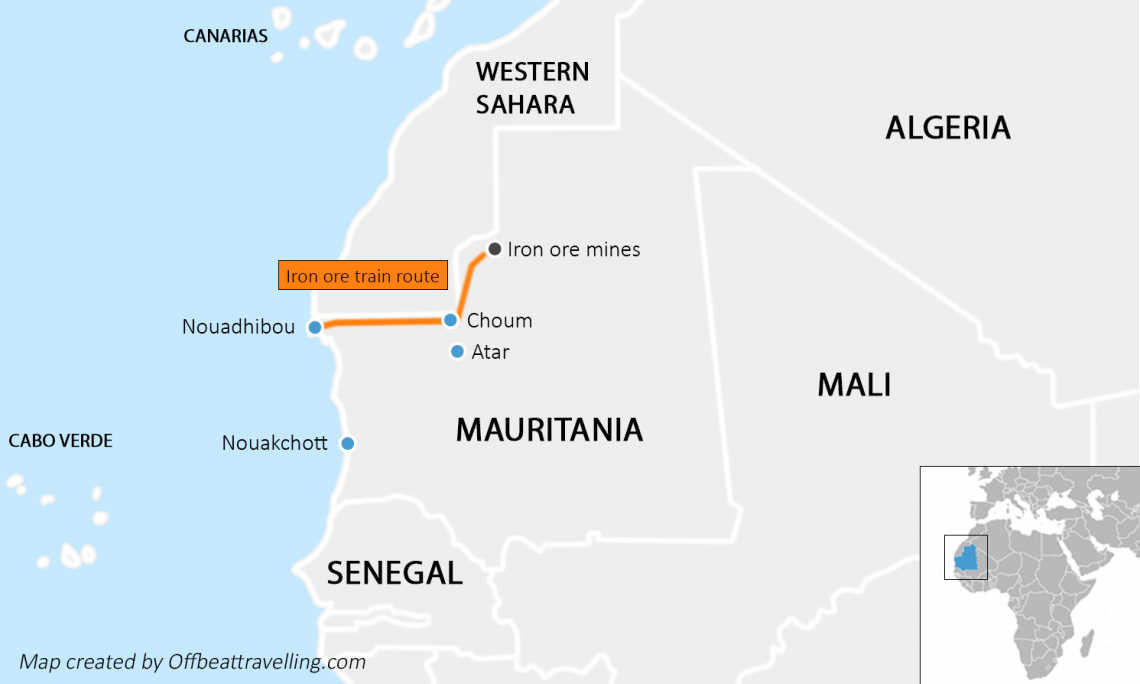
But hidden away underneath the sand, away from the public in a remote corner and military zone, lay crazy amounts of precious iron ore deposits.
Those ores are so important for the poor country that they are mined around the clock. Super long and heavy diesel trains, often up to 2km long, then transport the goods straight through the desert to the coast.
If you are crazy enough, you can track these trains down in the middle of nowhere, jump on one of the cargo wagons and hold on for dear life to hitch a free ride.
And yes ladies and gentlemen, that is exactly what I did.
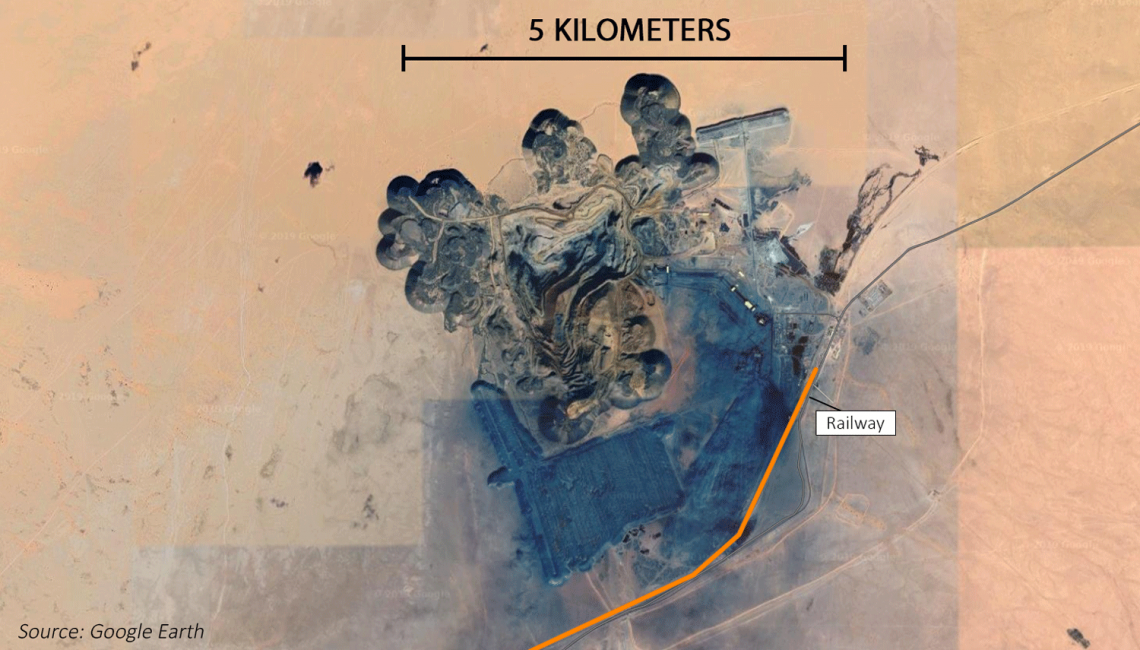
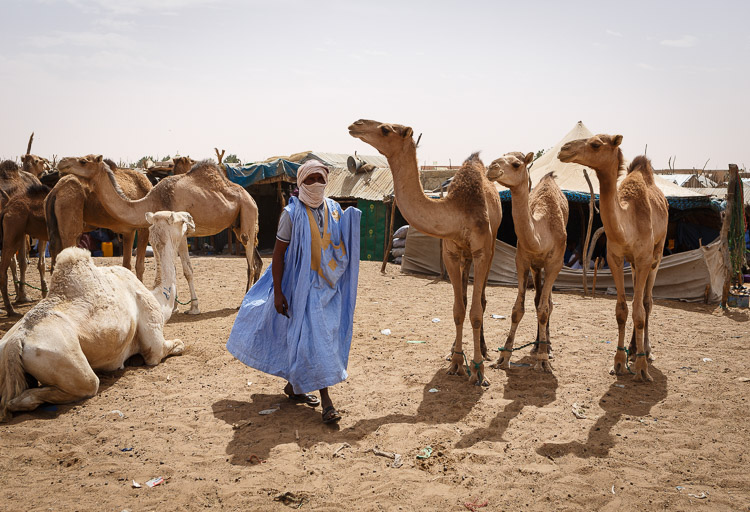
Al-Qaida
No tickets, no reservations needed, pretty cool right? Well, in fact the train doesn’t even have a time table, let alone precise info of where the train stops. For those who might wonder: there is also no such thing as booking an ‘iron ore train tour’ at your nearest tourist agency.
Reason one is that riding the train right on top of the iron ore is not an official thing. Yes, there are occasional passenger wagons that the locals use. But for the ultimate adventurer there is only one way, and that is to sit right on top of the ore. Only few people have done this, and even less have ever written about it.
Secondly, Mauritania is still largely avoided by tourists due to several security incidents in the last decade, incl. kidnappings of Westerners by Al-Qaida. The US government states on its website (Nov. 2018) that “a credible terrorist threat against foreigners remains” and advises to reconsider travel to the country. The Dutch government also warns against travel in half the country and advises not to go out after sunset (Jun. 2019).
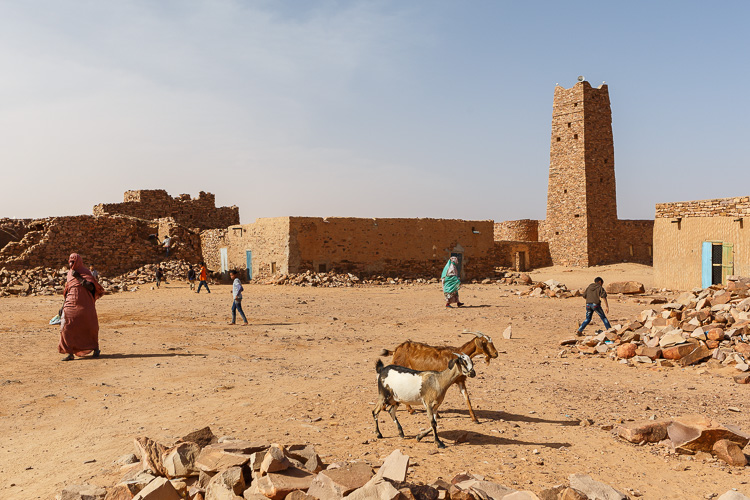
But all these warnings never held me back. Security has increased in recent years, and so despite concerns I finally flew to the capital Nouakchott early February this year. A good time to visit, as day time temperatures ‘only’ reach about 32 degrees Celsius.
What is even better, is that I could convince my good friend Marcel to join me some days later so we could ride the train together. I figured for such a mad idea, you cannot do it alone.
Getting there: checkpoints
As expected, security was never an issue in Nouakchott. I spent several days exploring this unusual city while staying with a local. There were certainly some highlights but I’ll save that for another blog post.
The tense security situation did become more visual when me and my friend travelled away from the city further into the desert, on our first leg towards catching the iron ore train.
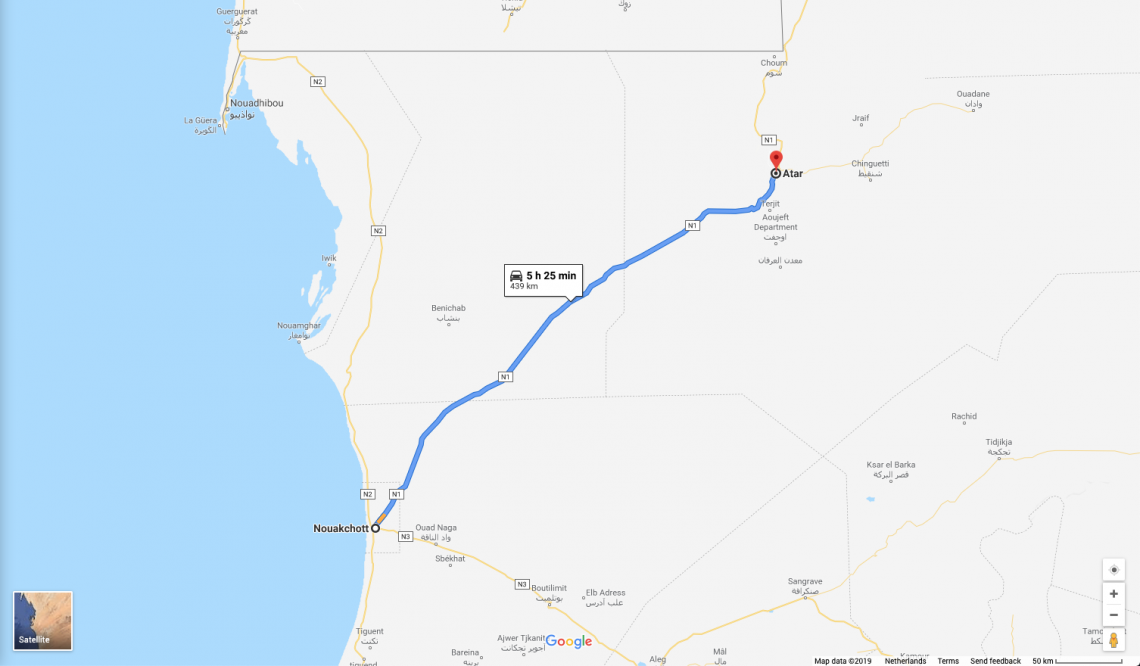
Our destination was Atar, a strategic city and main transport hub about 450 km away. Remote as it is, we learned that strangely enough there are direct flights to Paris once a week. Nevertheless we travelled by local minivan, passing through sleepy villages over a long, dusty and empty road.
A journey that would theoretically take around 4-5 hours, but took more than 8 due to the many checkpoints along the way. To minimise the time lost, we did have a special trick. We brought specially prepared ‘fiche‘ – a piece of paper with our personal details written down in French.
The idea is that as the minivan gets stopped, you as a foreigner hand over the fiche to the soldier and immediately continue the journey without ever handing over a passport or getting out of the car.
It’s an unlikely system that is hard to understand how it can improve security. There are so many ways to manipulate what you write down, but it works like a charm. I was requested a fiche almost 20 times during my time in Mauritania, and they never checked on me any further.
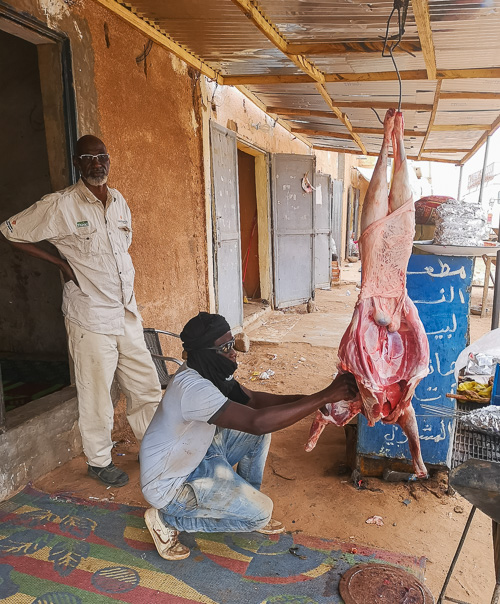
Buying winter clothes in the desert
Upon arriving in Atar we decided to spend a few days in the surrounding desert villages, sleeping in local tents along the way. We hired a driver and 4WD to take us wherever we wanted to go, which I want to say was pretty sweet. It actually reminded me a lot of the week-long rally I drove years back in Morocco and the Western Sahara. Similar land scapes, unexpected oases and adrenaline pumping off-roading. I wrote a cool article about that trip, which you can find here.
Back in Atar again we booked the last two seats in the only minivan to get to a village called Choum. Here we were supposed to find the railway tracks. With only little time before our departure we quickly bought food, lots of water and went searching for second-hand winter clothes. It would protect us against the cold and, maybe just as important, protect our own clothes from the destructive iron ore dust.
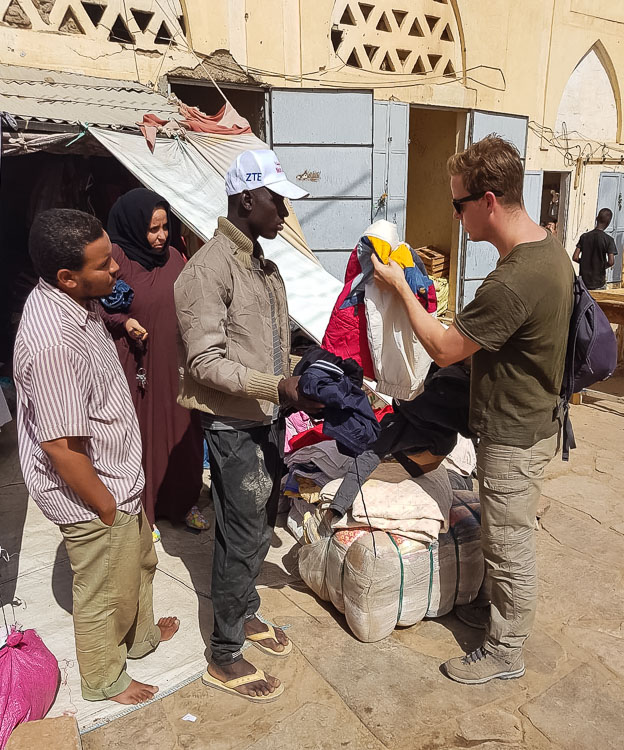
So we visited the only shop in town selling second-hand clothes. After tough negotiations I settled for 20 dollars, which gave us two winter coats, two trousers and two thick blankets. We hurried back to the minivan hoping to arrive in time in Choum.
Kids and goats
The 3-hr journey was an easy one and we arrived just before 6pm. Choum itself is an insignificant place. Hot, dusty, ugly, all shops closed, nothing going on. The local kids annoyed me more than anywhere else. Begging and screaming relentlessly for money and candy, not giving up. At some point I was surrounded by a pack of screaming kids and it was really out of control.
All I could think of was getting the hell out and start searching for the train tracks. From what we had heard, the train could be arriving at any time…
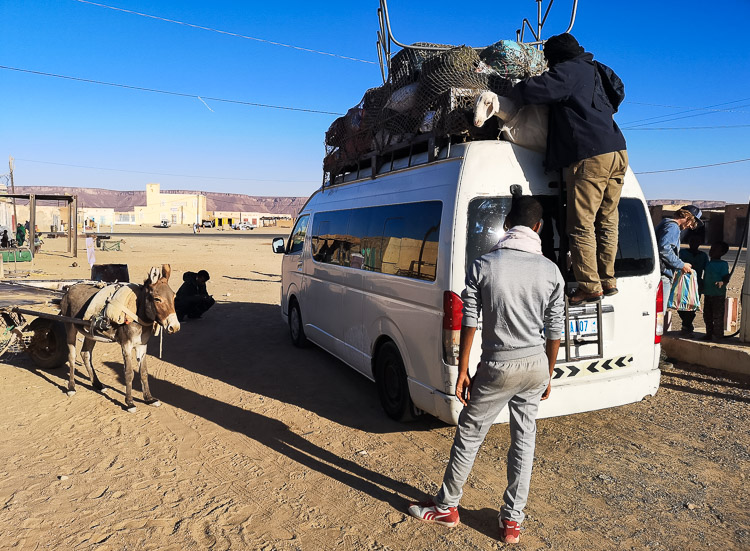
Now there is no obvious visual identification along the tracks to know where the train stops. We did spot a group of 20 men and young boys in the distance, casually waiting around with 50+ goats. I reckoned they were there for a reason, so we set up base about 100 meters from them. Unfortunately three kids had followed us all the way and they were still not letting go of us.
Then I noticed a group of four Czech travellers waiting around 300 meters further down at a small house that looked like a train station. Obviously they were there for the same reason as us. I told them to come a bit closer as the locals were probably better positioned. If you stand in the wrong place, you risk a mad run to get to the wagons before the train starts moving again.
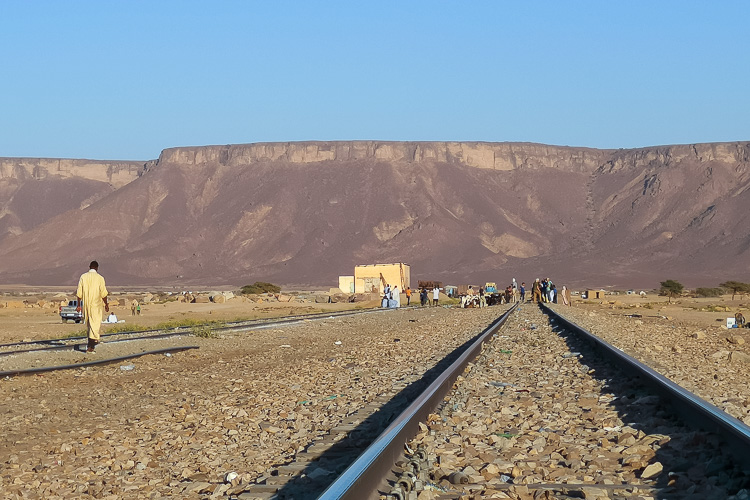
Luckily already after an hour or so a massive train doomed up in the distance. THIS WAS IT.
I couldn’t be more excited. Maybe not even because of the train ride ahead, but because of finally getting away from this place.
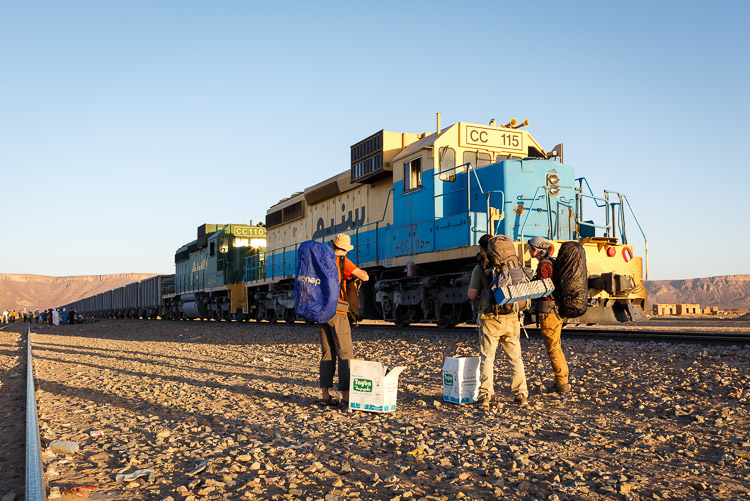
We picked a random wagon at the front and I was the first to climb up. We had no idea when the train would start riding again, so I told Marcel to quickly hand over all the backpacks. He then also climbed in and together we checked if everything was in order. I went back down to photograph the loading of the goats and five minutes later (again) rushed back on.
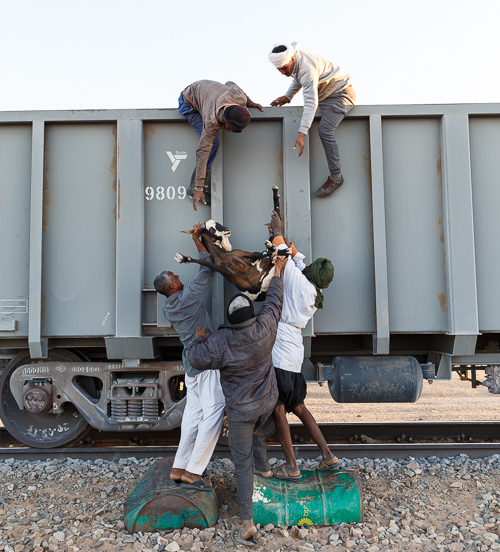
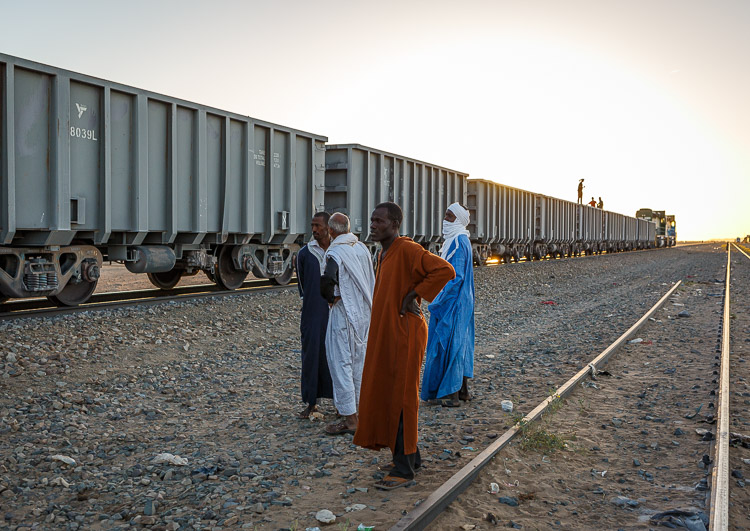
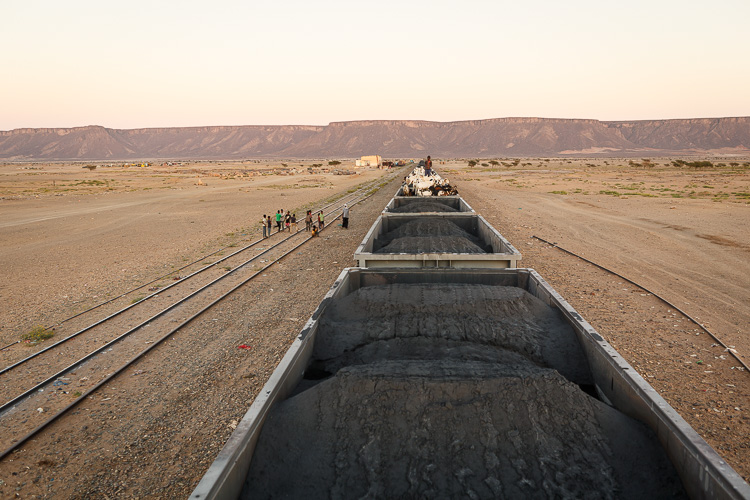
Then the train started moving again, lurching violently as the towing pressure built up over the entire column. It forced us to sit down on the iron ore in order not to fall off while we waved goodbye to the locals.
We quickly packed up everything in plastic bags and put on our second-hand clothes. To protect ourselves from the flying dust we had taken some items with us from back home. The genius in me assumed a pair of swimming goggles and a simple dust mask would do, while Marcel brought a skiing visor.
As a last preparation we had to flatten out a small section in the wagon where we would be sleeping. The ore was not easy to move around, but we managed to flatten a one meter-wide space using our shoes as shovels.
And so the wind was blowing heavy in our face, the views were fantastic and we were still clean and well prepared. What an adventure.
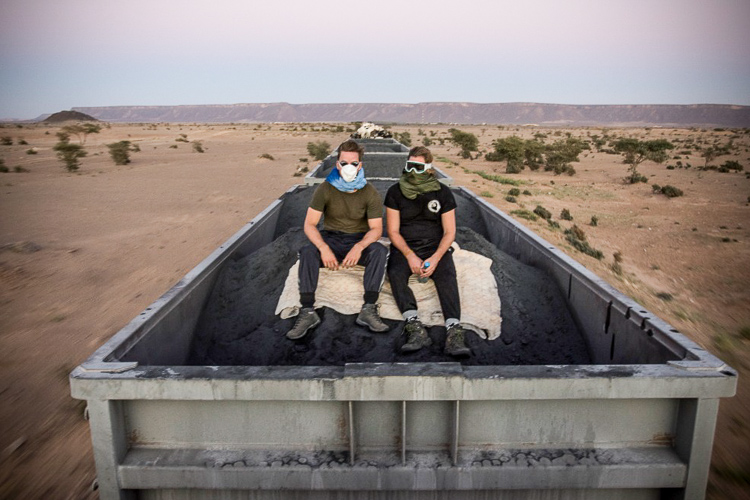
Shaken and woken up
What followed was an epic but rather tough and miserable journey throughout the night.
First of all I remember the train stopping in random places numerous times, sometimes for what feels like more than half an hour. Each time the locomotives started moving again we were violently shaken and woken up inside our wagon due to the towing pressure building up.
It was also really cold since our two blankets turned out too small to do the job. All night Marcel and me struggled to share one. We ended up in an endless tug of war, which he won. Our second blanket was supposed to function as a mattress but was totally useless on the hard and cold ore.
Last, I suffered several claustrophobic panic attacks because for hours in a row I was wrapped up so tight around my eyes, mouth and nose that I sometimes struggled to breath. The goggles also turned out completely inadequate, fogging up on the inside, making things even worse.
All in all for me it was a pretty restless night. Late in the night I actually gave up on trying to sleep. I climbed out from our improvised sleeping corner and just sat on the iron ore for hours waiting and waiting.
The only benefit from that is that I could watch the entire sunrise unfold in front of my eyes, one of the most beautiful sights ever. After taking a few pictures I woke up Marcel to join. The pictures we shot together you can find below.
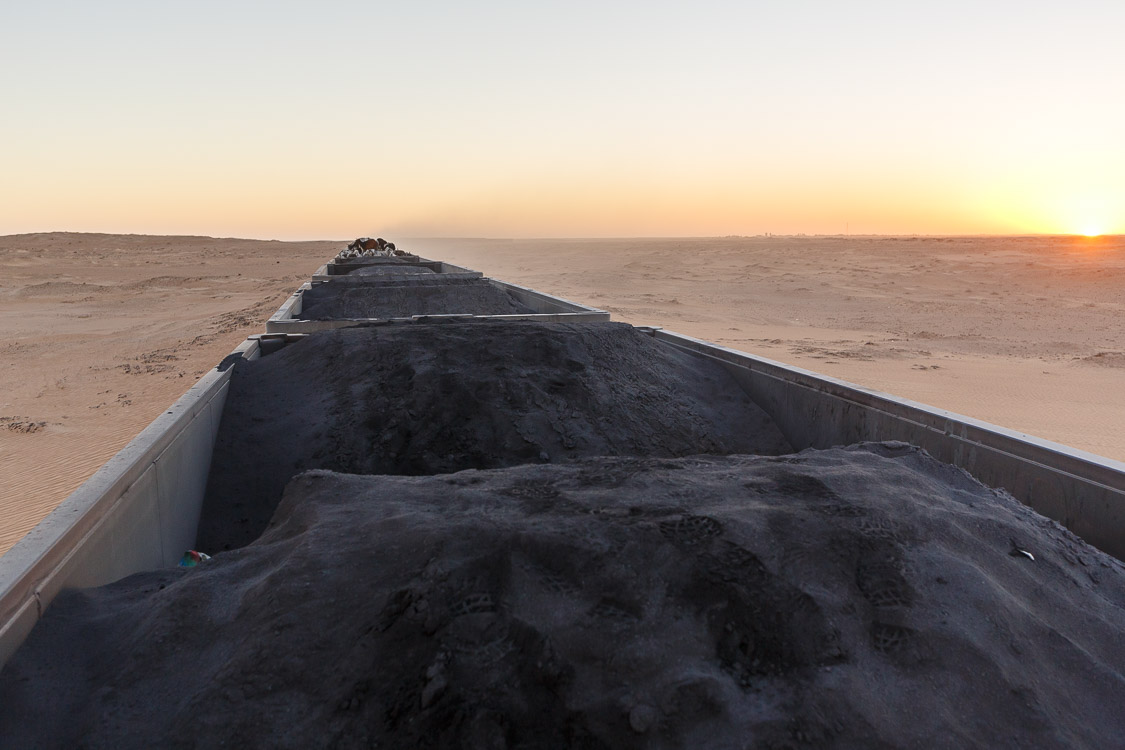
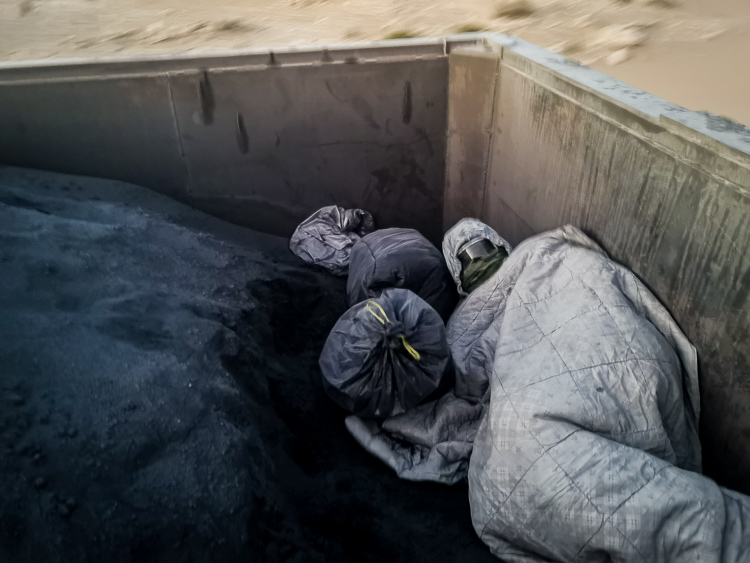
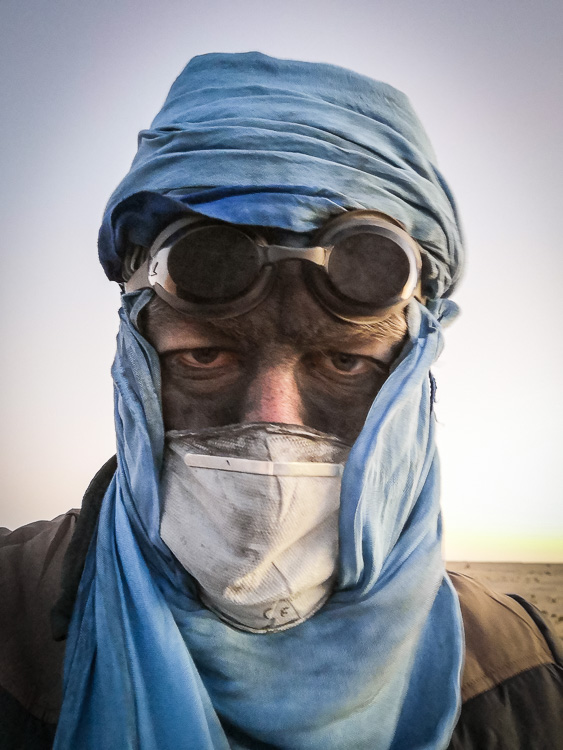
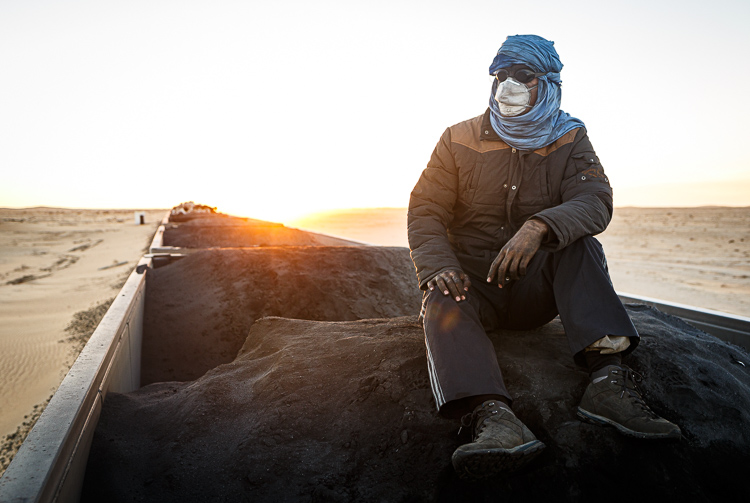
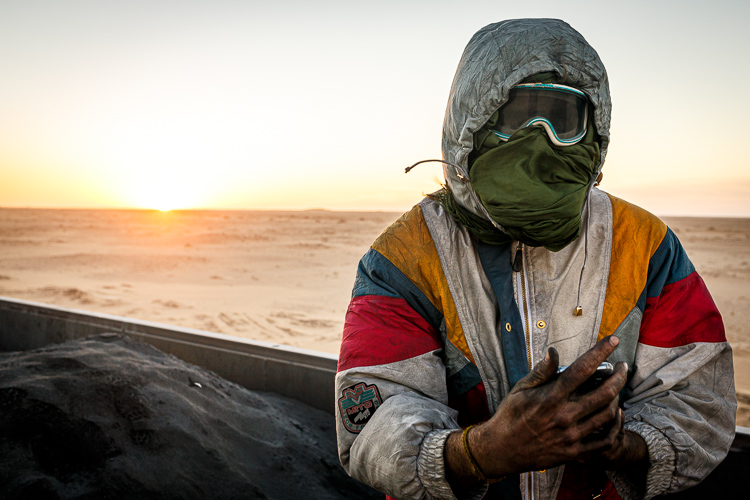
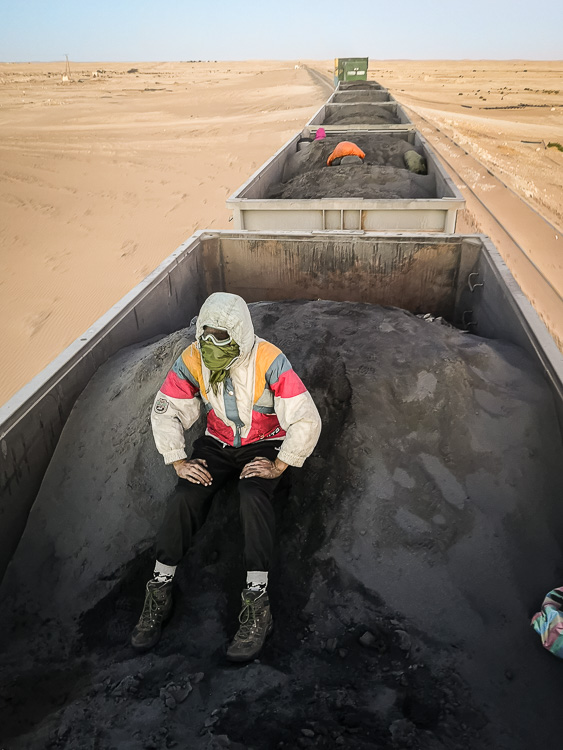
Finally after 15 hours (!) we reached Nouadhibou, the train halting 10 km before the city. We climbed out, high-fived and celebrated that we had survived the trip. Looking like Jack Sparrows we flagged down a car and started our search for a good shower.
The dust from our bodies might have come off by now, but the memories will remain forever.
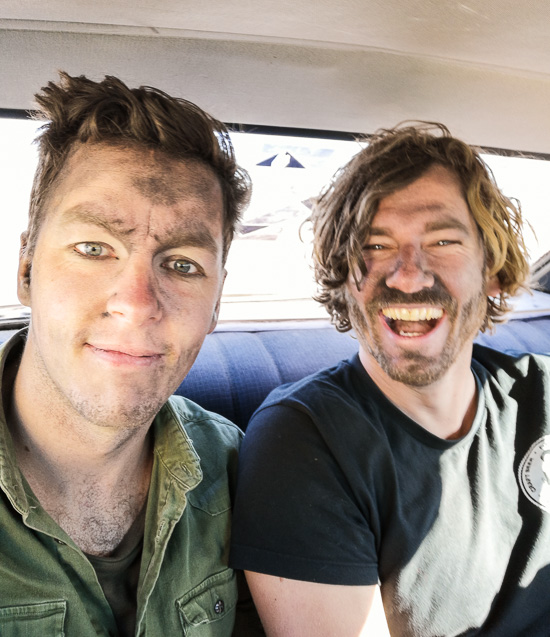
Planning to go yourself? Here is some important advice:
- Taking the train is best avoided during winter months – it will simply be too cold at night. Also keep in mind that summer months are not ideal to be in Mauritania either!
- There is no precise time table, but most trains leave Choum for Nouadhibou anywhere between 6pm and 11pm. Some days there are even two. The day we left ourselves at 7pm, a second train pulled up around 11pm, this one with a passenger cart. My advice though is to get to Choum around 5:30-6:00 pm like we did, so you can take the early train and don’t miss out on a good sunset.
- Safety first! Bring a skiing visor or safety goggles and a proper dust mask that is easy to wear at night and in which you will be comfortable to sleep (check for example on Amazon). Without protection you might risk damage to your lungs and eyes!
- Bring several large plastic bags to store away your backpack during the trip. Make sure you have everything you need within easy reach since you do not want to open the plastic bag until you get out of the wagon again.
- To insulate yourself from the cold ore, perhaps you can try to bring two large carton boxes and fold them open as a mattress. There is a good reason why homeless people often sleep on cardboard!
- You can choose any wagon you want, but I would say the best views are in the front as you can see the entire train length. Don’t get too close to the locomotive though or the deep sound of the diesel will drive you nuts. If you go all the way in the end you risk sitting in the dust all the time.
- Taking the train alone is not recommended. It’s always good to have someone watch your back, especially if you are a female. There could be others taking the train, and there is really no way to get help once you are in the desert.
Daydreaming about epic travel adventures, crossing off bucket lists in mysterious countries far away from home. Would you ever ride this train yourself? Let me know by leaving a comment down below or let’s chat about it on Instagram!